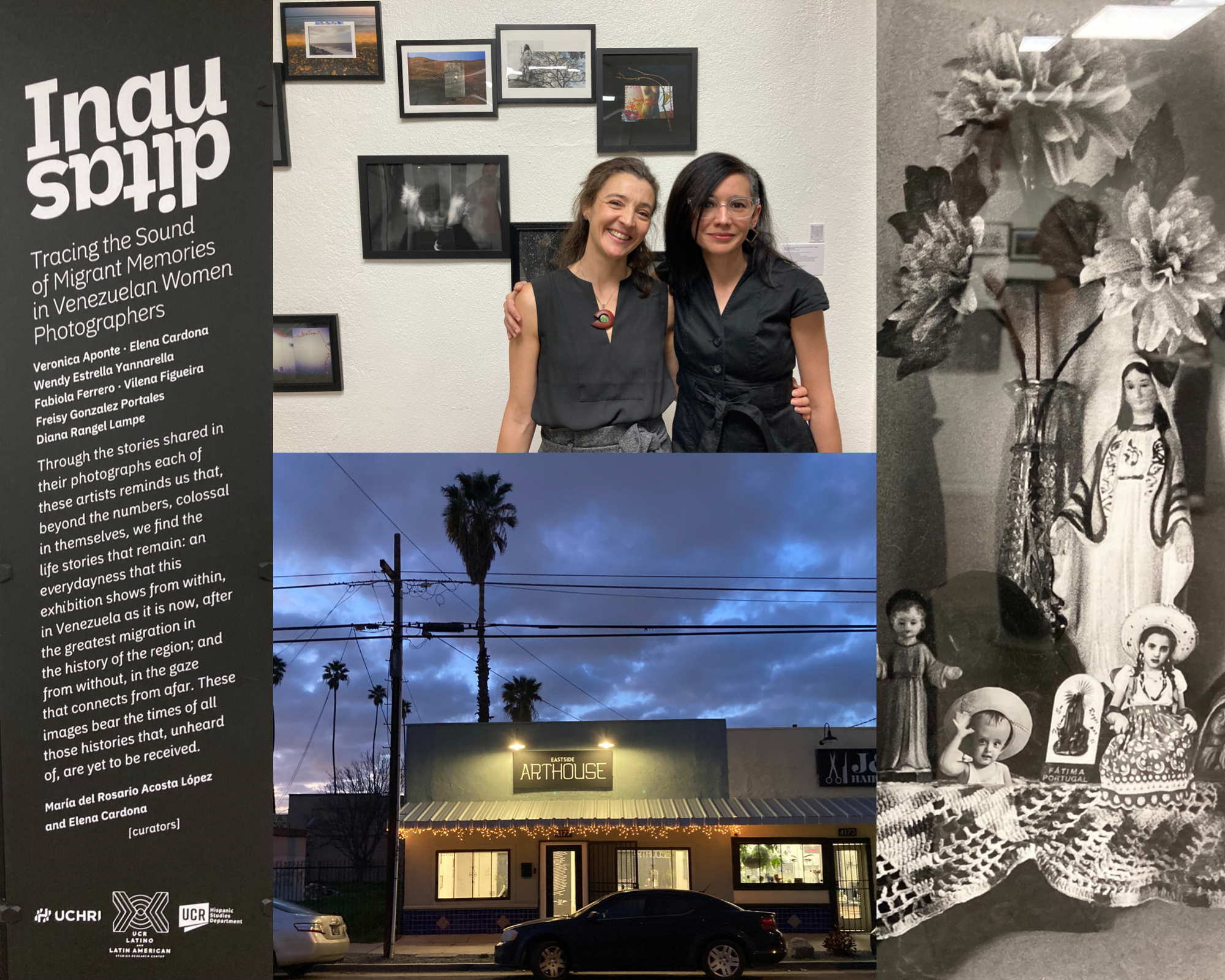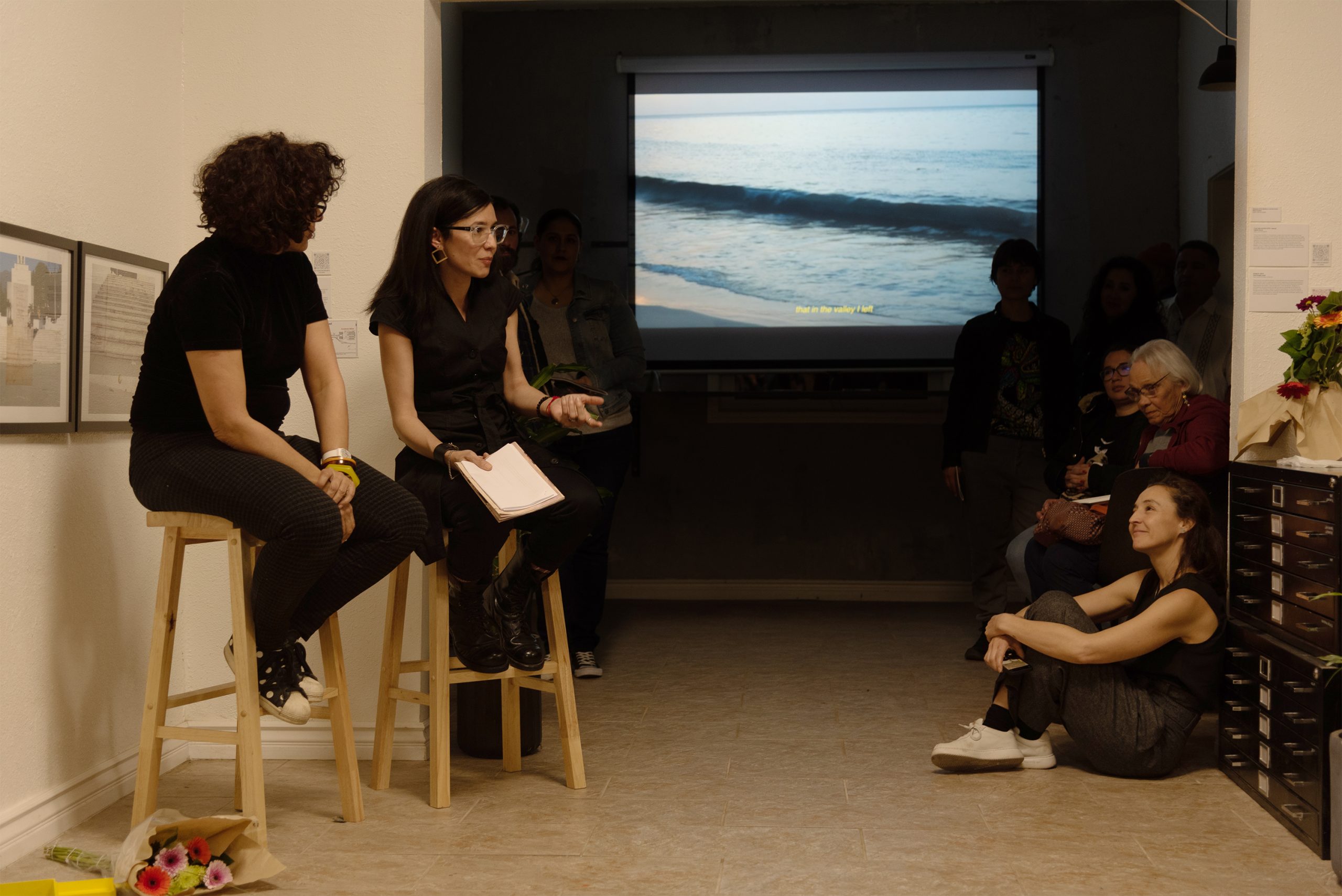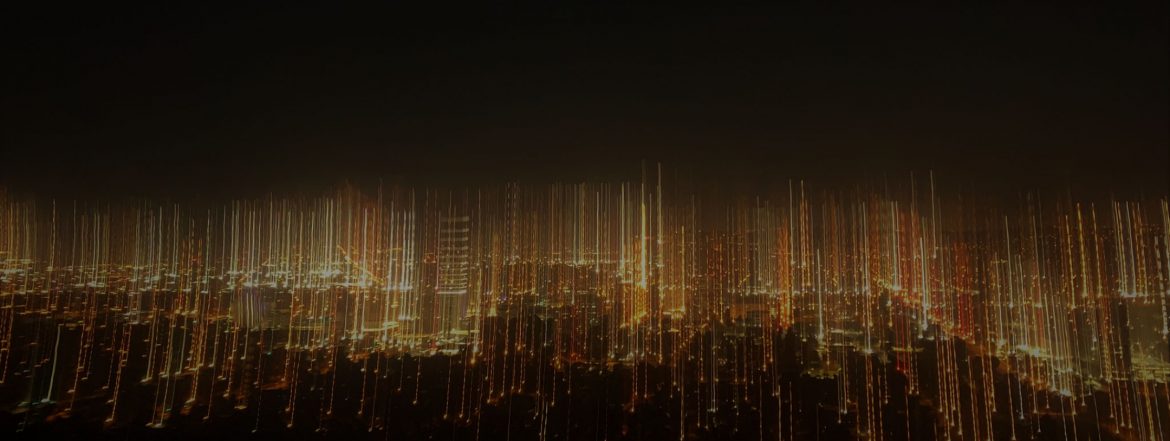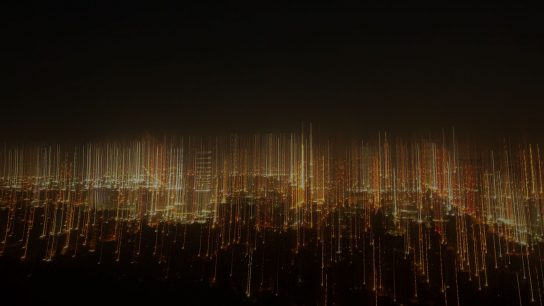On the (In)audible in Art: An Interview with Elena Cardona
by
Elena Cardona (UC Riverside) spoke to UCHRI Research Grants Manager, Sara Černe, for a new Foundry series highlighting the work of the Institute’s recent grantees and the methods, unorthodox approaches, and challenges they have employed and encountered.
“I insist that photography is a valuable way of knowing that can expand academic discourse and its methodologies toward more collaborative dynamics to understand and transform our contemporary reality.”
Tell us about your project and the ways in which you are bringing your research to the public.
On the (In)audible in Art (Part I): Tracing the Sound of lo inaudito in Venezuelan Migrant Women Photographers is a community engagement project resulting from two ongoing research projects: my dissertation on “Poetics of Migrant Memories” and my mentor María del Rosario Acosta’s project “Grammars of Listening.” A major key that has brought us closer has been to address how aesthetic devices bring to light and transform the understanding and intelligibility of an experience that exceeds what is understandable to us as ‘narratable.’ That is, how art reorganizes and expands our senses to render audible, memorable, and intelligible what has been unheard of, because it is inaugurated as an experience for which we do not yet have comprehension protocols.
In this stage of the project, we explore Venezuelan migration through the artistic projects of seven Venezuelan women photographers (Diana Rangel Lampe, Elena Cardona, Fabiola Ferrero, Freisy González Portales, Verónica Aponte, Vilena Figueira, and Wendy Estrella Yannarella), developed between 2016 and 2022. These offer a personal and intimate reflection on the experience of migratory grief through creative processes that defy interpretation protocols and the limits between languages and media by expanding the visual toward aural or haptic effects. Positioned from our own context of Southern California, we proposed an art exhibition that makes accessible these works of art to other researchers and artists as well as a wider audience. The exhibition promotes dialogue between these migrant memories and the stories of migration that accompany most of the Chicano/a/x and Latino/a/x communities in the Inland Empire. We want to offer visitors a multimodal experience that combines video, photography, and interview audios, to open other ways of making audible, perceptible, and experienceable the stories that otherwise remain unheard of. To extend community engagement, we prepared a slate of public programming activities, including guided tours, a round table with the artists of the show, a photo collage workshop by Freisy González Portales, and a participative poetic action by Adriana Rondón-Rivero, a Venezuelan woman artist based in California.

How does your work as a photographer engage with and inform your scholarship and what are some tensions you encountered in moving from one realm to the other?
I cannot conceive of one part of my academic life that is not informed by my work as a photographer. Photography has given me a way of relating to people, to the situations I face, and even to the things around me from which I cannot escape. It has made me more observant of details, it has trained me to be patient, to be silent until the right moment. It is already an imprint of my way of discernment. I admit that this same statement could work in reverse. My background in literature and philosophy has permeated my way of taking on photographic projects as well. For me they are two forces that feed each other. This is why I have incorporated activities that involve taking photographs in my literature and language courses. And on the flip side, I incorporate poetry readings and creative writing exercises into my photography workshops.
“I cannot conceive of one part of my academic life that is not informed by my work as a photographer.”
Outside the classroom, photography has also set the tone for my research interests. The project with Acosta, as well as my own dissertation research, are clear examples of this. In fact, it was when developing my own photographic and poetic project on family photo albums and migration that my first research questions arose. On that path, I discovered the ongoing projects of Venezuelan female photographers, which became the focus of my research and the exhibition.
Despite the fact that the academic and photographic fields are intertwined in my professional interests, it has not been easy to combine the demands of both fields. In particular during my PhD program, it is a balance that I must seek every day. For example, I include in my weekly schedule a minimum number of hours for specific tasks related to my photographic projects (archive cataloging, editing, portfolio review, exhibition work, or publication calls), just as I would with other academic projects. When I feel anxious about not reading or writing something for my dissertation (which happens with some frequency), I remind myself that those hours also nourish my academic thinking and writing. I insist that photography is a valuable way of knowing that can expand academic discourse and its methodologies toward more collaborative dynamics to understand and transform our contemporary reality.
What have been some of the main challenges of public-facing work and how have you addressed them?
Since we wanted to broaden the range of intelligibility of these themes, it was necessary to understand what spaces best foster the encounter between these works of art and a broader audience. We had to delve into our local, most immediate context, which was relatively new for both me and for Acosta, since both of us had only moved to the area a few years prior.
So we started with our known networks inside and outside of the academy. Maria Rios-Mathioudakis, a socially engaged artist based in San Diego, California, became a key contact in the search for photo labs and other services, and Dr. Alfonso Gonzales Toribio, Director of the Latino and Latin American Studies Research Center at UC Riverside, activated his long-standing ties to Latino organizations in the Inland Empire to broaden our options for hosting the exhibition.
This stage of our project also gave us the opportunity to come into direct contact with local artists and non-profit organizations that work on a wide range of social action and community engagement activities. Of course, new concerns and questions arose from these connections. From there, we have had to readjust not only the technical or material aspects of the exhibition in order to adapt to what is feasible, but also to ask ourselves how our curatorship can contribute to the processing of experience.
A third challenge that I can’t fail to mention relates to budget and vendors. The budget is a nightmare for researchers. But the issue is not only money, it is also finding the right providers for what you need. And do not forget that in addition to the cost/quality ratio, other details like delivery times and shipping conditions must also be considered. When you are not yet familiar with the service providers you need, it is best to consult with other people with expertise who hopefully already know the area. We, for example, consulted with artists and curators and also compared exhibition projects of different scales. In addition to that, we also ran our own online searches comparing rates and reviews.

As a graduate student, how have you experienced the types of collaboration this project opened up and did working on this grant influence your sense of what was possible in academia?
“Being involved in each part of the project, from the conceptualization and design of the proposal, through the budgeting and the scouting of equipment and services, to the subsequent production phases, has been an active learning process […] From the beginning, [Acosta] invited me to build this project with her as a co-PI. This gesture of trust and respect meant a lot to me and increased my motivation to participate in the project.”
Collaborating on this project with María del Rosario Acosta has been one of the most enriching experiences I’ve had as a graduate student at UC Riverside. I mean this in the broadest sense because it has led me to expand my theoretical framework to address the case of Venezuelan migration around the question of trauma and memory that underpins Acosta’s approach, and to explore other frames of meaning that listening makes possible. This reorientation meant an important turn in my doctoral research because I found new ways to address the questions I was asking about the role of photography and its limits as an aesthetic device to face radical experiences that defy representation.
The growth that this project has offered me goes beyond this theoretical or philosophical dimension. Being involved in each part of the project, from the conceptualization and design of the proposal, through the budgeting and the scouting of equipment and services, to the subsequent production phases, has been an active learning process. I was able to train myself in each of these aspects in a new context, gaining hands-on experience and having to propose solutions and make decisions, when necessary, always in dialogue with Acosta as a supportive colleague, more than just a mentor. From the beginning, she invited me to build this project with her as a co-PI. This gesture of trust and respect meant a lot to me and increased my motivation to participate in the project. She showed respect and appreciation for my experience as a researcher, photographer, and curator, and at every moment encouraged me to take center stage and incorporate my own ideas. This experience and the support of the UCHRI Engaging Humanities grant opened a broader horizon of expectations in my prospective career as a scholar, not only about the topics to be addressed in academic research but also about fostering collaborative spaces that build bridges toward the reality of local communities and other audiences beyond academia.
Banner image credit: Elena Cardona


